|
CYMRU LAND OF SAINTS AND HEROES Tan Wee Cheng's journey through the history & culture of Wales |
|
CYMRU LAND OF SAINTS AND HEROES Tan Wee Cheng's journey through the history & culture of Wales |
Mid-Wales:
Heroes and Crosses
A famous taspestry commemorating the defeat of the French near Fishguard
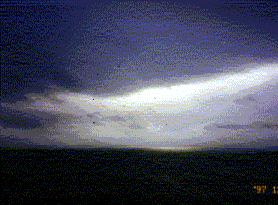 After this we drove
northwards along the beautiful coast, passing Fishguard
(Abergwaun) and Newport (Trefdraeth). Fishguard was where the
French launched the last invasion of Britain 200 years ago and it
failed miserably. The 1,400 French soldiers came in the wake of
the French Revolution, on 22 February 1797, thinking that the
Welsh would rise in support of the French liberators, found
instead hostile natives. The bold ladies of Fishguard, dressed in
traditional Welsh costume and led by a shoemaker's wife, marched
forth with pitchforks. The nervous-wrecked French saw in a
distance scarlet tunics and tall black hats, thought that they
were surrounded by a large British army, promptly surrendered
without a fight.
After this we drove
northwards along the beautiful coast, passing Fishguard
(Abergwaun) and Newport (Trefdraeth). Fishguard was where the
French launched the last invasion of Britain 200 years ago and it
failed miserably. The 1,400 French soldiers came in the wake of
the French Revolution, on 22 February 1797, thinking that the
Welsh would rise in support of the French liberators, found
instead hostile natives. The bold ladies of Fishguard, dressed in
traditional Welsh costume and led by a shoemaker's wife, marched
forth with pitchforks. The nervous-wrecked French saw in a
distance scarlet tunics and tall black hats, thought that they
were surrounded by a large British army, promptly surrendered
without a fight.
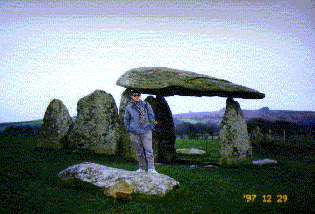 We
also made brief stops at the 4500 year old Neolithic burial site
of Pentre Ifan and the Chur ch of St Brynach in the cute little
village of Nevern. Pentre Ifam looked pretty close to the A487
main road but it took us a terribly long time through a narrow
wounding country lane to reach there. Anyway, the tomb lies on a
beautiful meadow surrounde d by wheat fields. Here, one sees a
16-foot-high capstone supported by 7-foot-high boulders. It was a
foggy day, and that added to the sense of timelessness and
mystery. It's back to the days of Merlin!
We
also made brief stops at the 4500 year old Neolithic burial site
of Pentre Ifan and the Chur ch of St Brynach in the cute little
village of Nevern. Pentre Ifam looked pretty close to the A487
main road but it took us a terribly long time through a narrow
wounding country lane to reach there. Anyway, the tomb lies on a
beautiful meadow surrounde d by wheat fields. Here, one sees a
16-foot-high capstone supported by 7-foot-high boulders. It was a
foggy day, and that added to the sense of timelessness and
mystery. It's back to the days of Merlin!
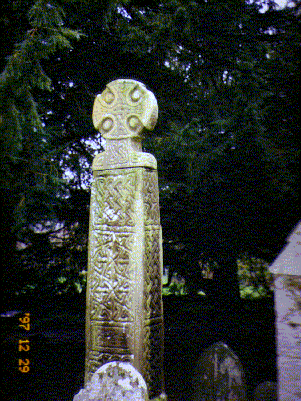 St Brynach was
another mystical Celtic saint. He lived a life of wandering,
first as the chaplain of an Irish warlord, then a pilgrim to the
Holy Land where he killed a monster, returned to Wales where he
was seriously injured by Welsh who were busy expelling Irish
settlers (ethnic cleansing isn't a new concept). He escaped,
recovered, expelled by evil spirits from a bridge-cell, chased
away in the next place he settled, but eventually welcomed by a
local lord to settle near Nevern. Here he built a church close to
the holy mountain Carn Ingli, upon which he would go to commune
with angels. Today, the church is famous for its ancient Celtic
cross and tombstones with inscriptions in the extinct ogham
script.
St Brynach was
another mystical Celtic saint. He lived a life of wandering,
first as the chaplain of an Irish warlord, then a pilgrim to the
Holy Land where he killed a monster, returned to Wales where he
was seriously injured by Welsh who were busy expelling Irish
settlers (ethnic cleansing isn't a new concept). He escaped,
recovered, expelled by evil spirits from a bridge-cell, chased
away in the next place he settled, but eventually welcomed by a
local lord to settle near Nevern. Here he built a church close to
the holy mountain Carn Ingli, upon which he would go to commune
with angels. Today, the church is famous for its ancient Celtic
cross and tombstones with inscriptions in the extinct ogham
script.
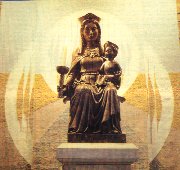 Speeding
northwards across the county of Ceredigion (Cardiganshire), we
paid a brief visit to Our Lady of Cardigan (Mair o Aberteifi), t
he National Shrine of Wales. This was where a miraculous statue
of Mary was discovered by the banks of River Teifi. We moved on
to the central town of Aberystwyth - famous for its university
and the National Library of Wales.
Speeding
northwards across the county of Ceredigion (Cardiganshire), we
paid a brief visit to Our Lady of Cardigan (Mair o Aberteifi), t
he National Shrine of Wales. This was where a miraculous statue
of Mary was discovered by the banks of River Teifi. We moved on
to the central town of Aberystwyth - famous for its university
and the National Library of Wales.
Click the pix to enlarge
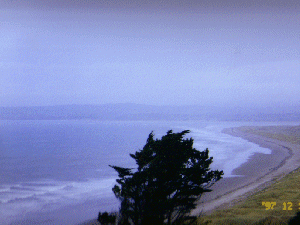 And then on to
Borth and its sandy beaches, before spending a night at
Machynlleth (pronounced "Mac-khan-n-cliff"), where the
Welsh national hero Owain Glyndwr set up the first Welsh
parliament. Descendant of the Welsh princes of northern Powys,
Owain Glyndwr led a rebellion in 1400. He was initially
successful, having stormed the great English castles everywhere
from Glamorgan to Anglesey, declared himslf the Prince of Wales,
and held his parliament at Machynlleth. But then the tide turned
- how can clannish, tiny Wales held against the enormous might of
England ? The English recovered castle after castle. Glyndwr's
last fell in 1409, and he continued as a guerilla. In 1415, like
other great heroes of Celtic Britain (e.g. King Arthur), he
disappeared as well, but legends say he would be back again one
day, and lead the Welsh to freedom.
And then on to
Borth and its sandy beaches, before spending a night at
Machynlleth (pronounced "Mac-khan-n-cliff"), where the
Welsh national hero Owain Glyndwr set up the first Welsh
parliament. Descendant of the Welsh princes of northern Powys,
Owain Glyndwr led a rebellion in 1400. He was initially
successful, having stormed the great English castles everywhere
from Glamorgan to Anglesey, declared himslf the Prince of Wales,
and held his parliament at Machynlleth. But then the tide turned
- how can clannish, tiny Wales held against the enormous might of
England ? The English recovered castle after castle. Glyndwr's
last fell in 1409, and he continued as a guerilla. In 1415, like
other great heroes of Celtic Britain (e.g. King Arthur), he
disappeared as well, but legends say he would be back again one
day, and lead the Welsh to freedom.
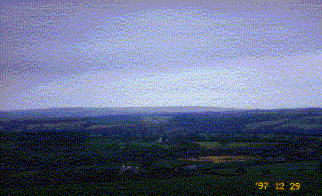
![]() Snowdonia
(Eryri) & Gwynedd - the Real Wales.....Stones,
Statesmen, 10,000 Saints & a Mysterious Isle.....Of
Spirits & Castles
Snowdonia
(Eryri) & Gwynedd - the Real Wales.....Stones,
Statesmen, 10,000 Saints & a Mysterious Isle.....Of
Spirits & Castles